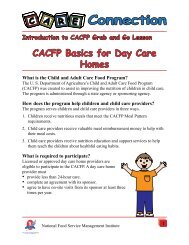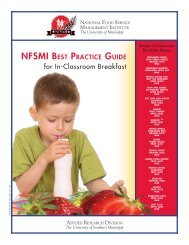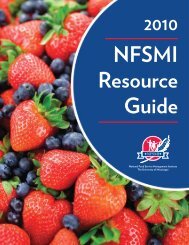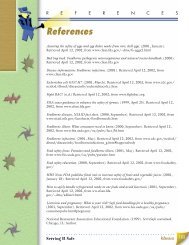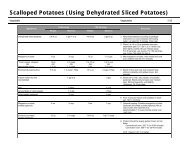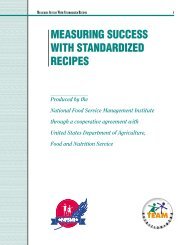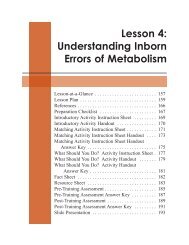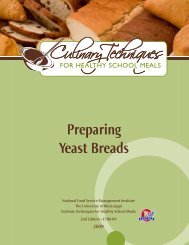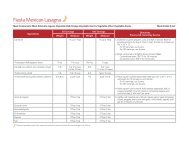financial management information system - National Food Service ...
financial management information system - National Food Service ...
financial management information system - National Food Service ...
Create successful ePaper yourself
Turn your PDF publications into a flip-book with our unique Google optimized e-Paper software.
B UDGETING S ECTION 5Factors that Influence Budget DevelopmentThere are several factors that must be considered by the school foodservice administrator during the budgeting process.Those factors include the following:• Historical trends - Are trends emerging in the number of reimbursable meals sold over the past two or three years? Dohistorical data indicate an increase or decrease in the percent of a la carte or extra sales to total sales? Have specialfunctions/catering services increased, decreased, or remained the same?• Participation rates - Is the school district in a period of increasing or decreasing enrollment? Does the school districtplan a marketing campaign to increase participation? Are there anticipated changes in the number of studentsqualifying for free/reduced meals that might affect overall participation? Are there operational improvements such asupgrades in school foodservice facilities that might result in increased participation?• Federal and state subsidies - How much will federal reimbursement rates increase (or decrease)? Will there be achange in the state subsidy? What will be the estimated dollar value of USDA-donated commodities? Is the cost ofcommodity delivery expected to increase?• Operational and/or program changes - Are there new federal program regulations that will increase costs due toimplementation? Are timesaving techniques being planned that will lower labor requirements? Are new services beingplanned to increase revenue?• Increased or decreased program costs - Do market reports indicate expected increases or decreases in the price offood, supplies, or services? Are raises planned for employees? Will benefits, such as health insurance, be added orincrease in cost?• Changes in meal prices - Will the price of lunch, breakfast or a la carte/extra food increase? Will a meal priceincrease result in fewer students and teachers eating school meals? Are there plans to increase the charges for specialfunction and catered meals?Methods Used in BudgetingThere are basically three ways to plan a budget. They are as follows:• Incremental (baseline) budgeting - In incremental budgeting, the budget for the current year is the starting point forthe new budget. Adjustments are made to the budget to allow for differences in activities planned for the next year andthe activities in the current year. Adjustments are also made to reflect expected changes in revenues and expenditures.The advantages of incremental budgeting are that it is less time-consuming and that it may be the best method forbudgeting basic cost items (e.g., communication charges or waste <strong>management</strong>). The disadvantages of incrementalbudgeting are that existing budget errors may not be corrected, less planning may go into the budget process, andadministrators may not take into account changing program needs.• Zero-based budgeting - The concept for zero-based budgeting is to start with zero and build the budget. It requires thatthe operation take a fresh look at every expenditure without preconceived notions. There are several advantages to zerobasedbudgeting. It better equips <strong>management</strong> to make decisions when comparing actual program performance to thebudget. Zero-based budgeting most often gives a better estimate of revenue projections and helps create a model forspending by breaking the habit of budgeting nonessential costs simply because they were incurred the prior year. Thedisadvantages of zero-based budgeting are that it is time-consuming and that some categories in the budget are bestestimated based on historical data because they are difficult to calculate from zero. For example, the cost of general suppliesmay best be calculated by examining existing data for historical usage combined with the projected rate of inflation.81N ATIONAL F OOD S ERVICE M ANAGEMENT I NSTITUTE



